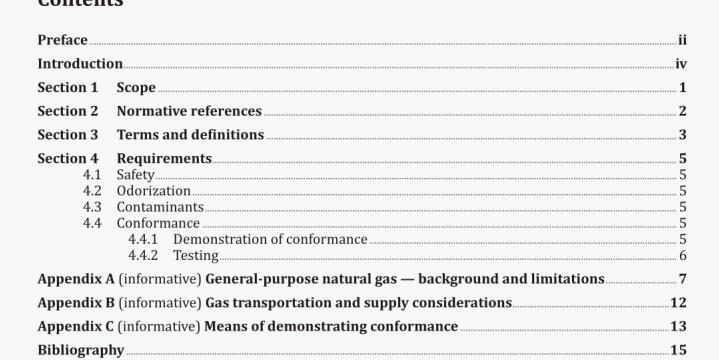General-purpose natural gas
AS 4564-2020 pdf download.General-purpose natural gas.
A.3.9 Hydrocarbon dewpoint
The hydrocarbon dewpoint limit controls the level of heavy hydrocarbons (propane and heavier) in the gas. At high pressures, condensation of heavy hydrocarbons may occur at low temperatures. The pressure and temperature specified do not guarantee the total absence of retrograde condensation.
Additionally, retrograde condensation can occur In transmission systems at pressures lower than the MAOP. It is this phenomenon that effectively determines the maximum allowable limits of heavy hydrocarbons in natural gas. The pressure and temperature specified are designed to limit retrograde condensation for Australian natural gases, refer to ISO 13686.
The specified pressure approximates the cricondentherm pressure which, for Australian natural gases, is usually within the range of 2 MPa to 4 MPa.
A.3.1O Total inert gases
The specification for total inert gases Is intended, in conjunction with the Wobbe Index limits, to limit the levels of higher hydrocarbons. High levels of CO2 in particular could have significant implications for some gas consumers with specific needs.
A.3.1 1 Other combustion parameters
Other combustion parameters (e.g. sooting index, flame speed and lift index) were considered but not deemed necessary for inclusion in the specification.
A.3.12 Oil
The limit for oil contamination is based on the Queensland Petroleum and Gas (Production and Safety) Regulation 2018, which in turn was based on Australian Pipelines and Gas Association (APGA) good current practice for compressor station operation. The limit is an acknowledgement that, while undesirable, It is almost inevitable that some oil will escape from filters and coalescers downstream from compressors and other facilities. The limit is intended to restrict oil accumulation in transmission systems to manageable quantities and to avoid network operation and appliance safety problems in distribution systems.
There are currently no suitable real time methods for measurement of entrained oil. Conformance to Table 4.1 is ascertained by retrospective logging of oil collected from filters or other entrapment elements.
A.3.13 Other contaminants
The level at which some objectionable constituents might cause damage or be a hazard to health are listed below:
(a) Elemental Sulfur: 1.0 pg/m³
Mercury is hazardous to human health if ingested, absorbed through the skin, or inhaled. Mercury can also cause “liquid metal embrittlement” and subsequent failure of aluminium alloys.
Mercury removal equipment for natural gas is reported as being able to reduce inlet concentrations of 25-50 pg/rn3 to 0.1 pg/rn3. The atmospheric concentration (depending on location) is generally around 0.02 pg/rn3 but higher in some industrial centres.
The mercury level of 1 pg/rn3 in natural gas will not add significantly to the background level in indoor air, is technically feasible and, upon dilution of the combustion products, will lead to concentrations well below the occupational health exposure level.
(c) Radioactivity: 600 Bq/m3
Radioactivity in natural gas is due primarily to radon. Radon is a chemically inert gas which produces radiation as It decays via a series of radioactive nuclides to lead 206, which is stable. Of these radioactive nuclides lead 210. which has a 22.year half-life, is of the greatest concern. It follows that the decay products of radon can create heavy-metal dusts which may accumulate in pipelines, vessels, and filters. In systems where natural gas is known to contain radon, protective measures should be taken in dealing with dust accumulations.
The radioactivity in natural gas limit of 600 Bq/m3 is such that the contribution of combustion products to the indoor radiation level will not exceed the recommended exposure monitoring limits set by the Australian Radiation Protection and Nuclear Safety Agency (ARPANSA) and will not add significantly to the background level in a house or factory from gas combustion.
Testing for radioactivity levels poses a number of problems and currently does not have a standardised test method. Typically this is tested for when a new producer first comes online to demonstrate whether radioactivity poses a hazard.AS 4564-2020 pdf download.
General-purpose natural gas
